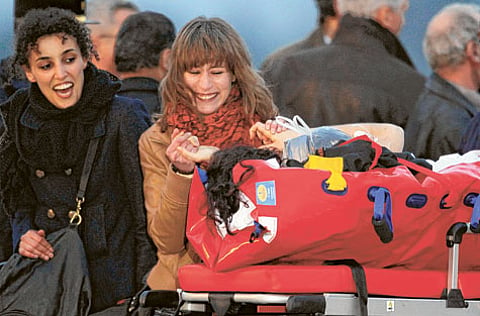British photographer likens killing in Homs to Srebrenica massacre
I don't know how people can stand by and watch this, Conroy says from his hospital bed

London: The world will look back in shame at the "indiscriminate massacre" that President Bashar Assad's regime is carrying out in Syria, according to Paul Conroy, the Sunday Times photographer who was seriously wounded in the city of Homs.
Giving an emotional interview from his hospital bed in London on Friday, Conroy compared the killing in Homs with the Srebrenica massacre, adding that the time for talking was past.
"As I'm talking to you now, people are dying," he told Sky News. "There was no restraint with the cameras there. God knows what's happening now the cameras are gone."
Conroy managed to escape into neighbouring Lebanon after suffering leg injuries in the same bombardment that killed his colleague, Marie Colvin, and Remi Ochlik, a French photographer, on February 22. Homs had suffered a "sustained barrage" that was "absolutely indiscriminate," said Conroy.
The "massacre and the killing are at full tilt," he said. "I don't know how people can stand by and watch this."
Systematic
Conroy, 47, an experienced freelance photographer from Totness, Devon, said the shelling had begun "religiously" every day at 6am and was worse than anything he had experienced in other war zones.
Syrian forces were "systematic in moving through neighbourhoods with munitions that are used for battlefields," adding that "men, women and children" were "cowering in houses" and "beyond shellshock". The Homs he left had been a city of "rooms full of people waiting to die".
He said: "They see nothing other than waiting for the moment the soldiers come in or the shell comes through the door."
Conroy escaped after five days sheltering in one building. "I came out and the street was gone," he said. "And in every one of those houses there were people."
He continued: "People brought me in half a baby, saying ‘where's the help?' And I have no answer. I don't know how we can stand by and watch this. It's not a war: it's a massacre, it's the indiscriminate massacre of men, women and children."
Conroy added: "In the years to come, we are going to look back, we are going to have the shame of sitting back and watching it again, as in Srebrenica, as in Rwanda, and we're going to say ‘how did we let this happen under our nose'."
Bodies
The bodies of Colvin and Ochlik were removed from Homs by the International Committee of the Red Cross. The corpses had been left inside the city during the bombardment and two previous attempts to recover them failed, leading to reports that Syrian rebels had buried them.
But the ICRC confirmed the bodies of the journalists had been handed over and were being transported to Damascus. Javier Espinosa, a correspondent for Spanish newspaper El Mundo, also escaped from Homs after being trapped in the bombardment.
Sign up for the Daily Briefing
Get the latest news and updates straight to your inbox



